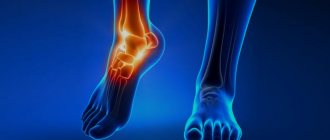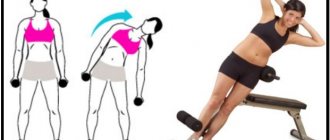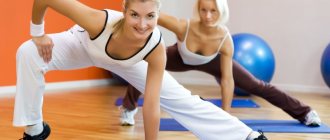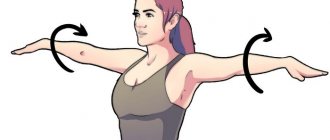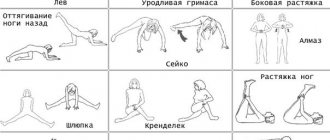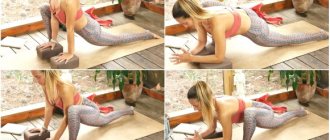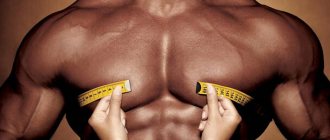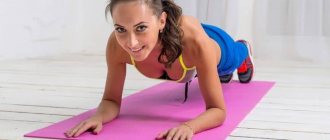What is exercise therapy for varicose veins?
Varicose veins have a hereditary etiology.
Weakness of blood vessels and poor blood circulation provoke this disease. The more advanced the stage of the disease, the more pronounced the symptoms.
Visible manifestations of changes in the skin. Venous nodes form under the skin.
Any vascular pathology, including varicose veins, depends on physical activity. Exercise therapy is therapy.
Regular work will help activate the venous system. After all, it is in the legs, thighs and buttocks that the triggering mechanism is located.
Exercises for pregnant women
Many women ask the question of what not to do for varicose veins during pregnancy. The answer is not always clear; usually the doctor examines the patient’s condition and can then give specific recommendations.
Training during pregnancy has its own characteristics and limitations. Before starting training, you should consult your doctor. Exercises for pregnant women with varicose veins can be performed with your own weight or on special exercise machines and balls.
Exercises for pregnant women with varicose veins
Exercises:
- Stand up, place your feet a few centimeters apart, and stretch your arms along your body. As you inhale, slowly rise onto your toes. While lifting, raise your arms - this will widen the intercostal spaces and allow you to draw blood from the dilated veins.
- Mini-running with fixed toes. The exercise is done in several approaches throughout the day.
- In a horizontal position, place your ankle on a pillow so that your legs are higher than your torso. In this position, raise your legs for 45-60 seconds.
The benefits of therapeutic exercises
Classes have a whole range of positive actions that are visible already in the early stages. All you need to do is how to perform the complex correctly.
Gymnastics for varicose veins affects:
- the tone of the vascular walls increases;
- movements provoke active blood flow;
- fatigue passes, the person gradually accustoms the muscles to work;
- arterial blood gradually begins to improve its passage through the channels;
- dystrophic processes that overwhelm tissues during disease are stopped;
- relieve tension from joints.
Doctors insist that exercises for varicose veins help improve the painful situation.
The pathology recedes, swelling is eliminated, regeneration processes proceed normally.
The benefits of training
- Vein exercises can be performed in any room without spending money on special gyms.
- You can exercise by doing regular household chores.
- In the early stages, training can restore the tone of the veins and remove cosmetic defects.
- Sports activities prevent the formation of thrombophlebitis.
- In addition to treating varicose veins, physical therapy will help tone your body and cardiovascular system.
Phlebologists say: in the case of varicose veins, physical exercise is not only necessary, but is also one of the components of basic therapy.
It is important to understand! Regular exercise and exercise therapy for varicose veins are radically different.
Exercises for varicose veins on the legs
What you need to know before starting exercise therapy for varicose veins
Before performing exercises against varicose veins of the legs, you should consult a doctor. He should give recommendations for implementation.
Since this therapeutic exercise has its own nuances, without taking them into account, the result will not be achieved. In addition, you need to know which exercises are strictly prohibited.
The following were included in the black list of sports activities:
- static exercises with heavy weights;
- It is not advisable to do a squat, but sometimes you can use compression garments;
- a bicycle with this pathology is dangerous;
- jumping on the steppe with and without weight;
- physical activity without preliminary warm-up;
- Any type of game sports is harmful to sore joints.
The specificity of charging is aimed only at providing a therapeutic result.
What exercises are prohibited?
With severe varicose veins, any load on the lower limbs is prohibited. The patient will not be able to engage in professional sports, but at home he will have to adhere to the following rules:
- do not lift more than 4-5 kg;
- do not be constantly in one position, sitting or standing;
- spend more time in the fresh air;
- You should constantly monitor your breathing.
- walks should be leisurely during training;
In the later stages of varicose veins, you will also have to refuse massage, so as not to provoke blood clots. A phlebologist can prescribe lymphatic drainage massage in cases where the patient develops lymphostasis against the background of varicose veins. It is necessary to have such procedures done by a licensed specialist so as not to harm your feet even more.
A patient with varicose veins of the lower extremities should listen to his body. If after some actions or exercises you feel pain or heaviness, you should refuse them. And all procedures that alleviate the condition must be carried out systematically. Exercises, as well as the treatment of varicose veins in men in general, differ significantly:
Rules of therapeutic exercises for varicose veins
Physical therapy should be performed based on theoretical rules:
- Almost all tasks are performed lying down.
- You should not strain too much or jerk your muscles.
- At the initial stage, you should not load the body; perform each exercise no more than 3 repetitions.
- Loads are increased gradually based on the patient’s well-being.
- It is very important to remember that strength tasks are performed taking into account breathing. We tense the muscles as we exhale, relax as we inhale.
- After and before gymnastics, it is necessary to activate venous blood flow. This is done while lying down with your legs elevated.
- Charging should not be tiring; be sure to include rest.
- Choose a calm pace for execution; you don’t need to do anything forcefully.
- Choose a warm room for classes; in the cold, blood vessels constrict.
- A mandatory rule is to warm up before the main complex.
- It is necessary to regulate not only the number of executions, but also their duration. Start small.
- Treatment procedures are performed 3 times a week.
- Follow the regime, the main thing is regularity.
- The pulse should not be more than 120 beats.
Preventive gymnastics
In order for complex therapeutic exercises against varicose veins of the legs and arms to be effective, throughout the day you can repeat simple preventive exercises, workouts that absolutely no one will pay attention to either in a work environment or on the street.
- Sit comfortably on a chair with your back straight. Take off your shoes, raise your feet and move your toes up and down. This is an exercise created by nature itself, which many people do somewhere on a park bench when their legs are very tired.
- While sitting on a chair, take off your shoes and reach with your toes to the opposite wall of the desktop, resting your heels. Raise your legs and move and spread them several times.
- Remain in the previous position, lower your feet to the floor. Rotate your toes without touching the floor.
At home, you can add exercises in a lying position to the complex. Lying on the floor, bend your knees and rotate your ankle in one direction and the other. It is useful to rise on your toes and walk around the room, alternating the exercise with lowering onto your heels.
Recommended types of exercises for varicose veins
Exercises for legs with varicose veins are interesting and varied. There are a lot of sports that can not only cure the disease, but also become an integral part of your life.
Swimming or water fitness
In this sport, the body is completely relaxed, tension is minimal.
Water helps relieve stress and pain. The vascular system is also strengthened, which improves blood circulation.
Nordic walking
With such training, the legs do not take on the entire load. Through the use of ski poles, the weight is transferred to the hands.
Walking in the Nordic walking style helps burn off excess calories and saturate the body with oxygen. Very suitable for the prevention of varicose veins.
Yoga
Eastern methods help improve overall health. These measured, smooth movements evenly distribute the load on the body. The body is always in good shape.
Effective methods for treating varicose veins
Varicose veins limit a person's movements due to constant pain and a feeling of heaviness in the legs. Its treatment aims to:
- drug therapy;
- complex dietary nutrition;
- massage (as prescribed by a doctor);
- moderate physical activity;
- gymnastics.
Despite the fact that a person’s lower limbs hurt, there is swelling and there is a feeling of heaviness, exercise for varicose veins of the legs is extremely important, as it allows you to tone the veins, capillaries and blood vessels.
Physiotherapy
Some exercises that are included in exercise therapy for varicose veins are suitable for home, and some for work. Especially if your profession involves standing or sitting.
At home
For these activities you will need a chair.
- Just sit down on the seat and stretch your joints by rolling your feet onto your toes.
- In the same position, we raise the limbs and create an imitation of forward circular movements.
- Remaining seated, the hands are brought back and locked into a lock. Raise straight legs very slowly.
Exercises to prevent varicose veins in a lying position.
- This technique is quite effective if done correctly. Lie straight, bring your knees to your chest. We fix the head straight and release one limb down. Then we press the other one, and lower the bent one.
- Without straining, we lie down and twist our feet alternately in different directions on outstretched legs.
- Boat rolls.
- For varicose veins, the birch tree and scissors known to everyone from childhood are suitable.
- For good blood circulation, it is necessary to perform breathing exercises. Lying down, we inflate and deflate the stomach, tensing the abs as we exhale.
Exercises for varicose veins on the legs while standing:
- Imitation of cross-country skiing with poles.
- We roll from flat feet to toes.
- Place your heels on a slight elevation and leave your toes on the floor. Make rolling movements without bending your back.
- While holding on, move the joint bent at the knees and fix it on the fingers, then also with the other limb.
- Stand up straight, hands on your waist. Bend one leg at the knees at an even angle with the other and rise onto tiptoes.
- Probably a swallow known from school. We bend our body forward, keep our back straight and spread our arms to the sides. Slowly raise one leg back. With a raised limb, pull the toe and stand in this position for several seconds.
At work
People who sit or stand still all day simply need to get their blood flowing.
This is completely easy to do without leaving your workplace. For example, walk on your toes, or make rolling movements while standing.
During the break, the limbs can be slightly raised on a chair in an extended position. It also promotes blood circulation in the vessels.
Fighting varicose veins with exercises
Physical activity is designed to improve blood flow in diseased veins. It is useless to do this if the stage of varicose veins already requires surgical intervention. But if the disease has just begun, the exercises will be very useful.
What not to do
You should not lift weights. Forget about strength exercises for now, they will aggravate your condition. Excessive tension can cause weak blood vessels to burst.
Here are some questions from people suffering from varicose veins and their answers:
- Is it possible to squat with varicose veins? You can squat with your own weight. But, if exercises are difficult for you, it is better not to do this, even without a barbell. You cannot squat with a barbell if you have varicose veins.
- Can you do bench press? You can, but with caution, it is better to wear special compression stockings. You need to be careful with exercises that directly work the leg muscles, such as deadlifts, squats, leg extensions and leg curls. This is where you have to limit yourself. You cannot lift weights while standing on your feet. A leg press with a light weight will be helpful because you perform it in an inverted position.
- Veins are swollen after training, is it varicose veins? After visiting the gym, the veins become more pronounced and are visible on the surface. But it is necessary to distinguish varicose veins from labor venousness. In the latter case, the veins are pushed to the surface by muscles, they are smooth, without knots or mesh. They are usually large and single, bluish. Such veins appear on the athlete’s body in the area of the flexors of the legs, arms, chest, and neck. This is fine. If the vein is red or purple, thin, knotty and bordered by a mesh, it is varicose veins.
- Aerobics – light exercise. Can it be done for varicose veins? Unfortunately, during aerobics a person makes sudden movements and jumps. And it’s better not to do this. Although in the initial stages of varicose veins this is not important. The main thing is to remove the heavy load. But in the later stages, especially with thrombophlebitis, sudden movement is dangerous due to the detachment of a blood clot and catastrophic consequences.
You should be wary of anything that requires serious physical effort from you: strength exercises, speed running, interval training.
What can and should be done
Exercises for legs with varicose veins differ in dosed load. This is actually gymnastics for the joints. On the one hand, it forces the muscles to contract, and on the other, it does not cause much tension. All exercises for varicose veins are aimed at increasing blood circulation in the legs.
The simplest leg exercise for varicose veins is working with the feet.
This exercise is done like this:
- Sit or lie down so that your feet are higher than your knees.
- You can place a soft but elastic cushion under your knees.
- Imagine that the tips of your toes are a hand. Draw an even circle with it. Drawing is carried out by moving the leg at the ankle joint.
- Pull the toe towards you, continue to pull it when you reach the limit. You will feel a slight pleasant warmth in the calf muscle and its stretching.
- After this, stretch your toes, pull your heels down using the calf muscle.
- Turn your feet outward, then towards each other.
- Try this exercise several times.
In other words, we actively rotate our feet, contract and relax our calves. We do this with our legs raised up. This technique allows you to stretch the muscles located below the knee while sitting on the sofa or lying in bed.
A set of exercises for the whole body
The following activity combines a warm-up for the muscles and joints of the whole body and stretching. This is a simple and safe complex that improves blood circulation throughout the body.
Head and neck
Make a circle with your head 10 times clockwise and the same number of times in the opposite direction.
On each lap, try to stretch. There is no need to do it quickly, stretch out the pleasure. Feel the work of your neck muscles, enjoy it.
Then stretch your chin to your chest 3-4 times, and the back of your head to your back the same number of times.
Let's move on to the upper shoulder girdle.
Arms, shoulders
Move your shoulders in circles forward and backward. We draw a circle efficiently and slowly, stretching the muscles!
Next, we begin to describe circles in the same plane with straight arms. There is no need to accelerate too much; a speed of 1.5–2 revolutions per second is sufficient. We inhale and exhale evenly, without holding our breath.
Then we press our elbows to the body and draw a circle with brushes. That is, the arm rotates at the elbow.
And the last step is to clench your hands into fists and rotate them at the wrist. Next, we warm up the lower back.
Small of the back
Take the hands-to-sides pose. Start by using your lower back to turn to the maximum right and left 10 times. You can turn in a row, or you can immediately do 10 times in one direction, then 10 in the other.
After this, bend forward and backward. Then rotate your body clockwise and counterclockwise, keeping your legs in one place.
Place your hands on your hips and make a few circles with just your hips.
Don't forget that you need to work slowly at a constant speed.
Legs
Here you can squat 10 times slowly and without additional weight. This is one of two possible options for putting stress on your legs, because you cannot squat with a barbell or do lunges.
The second option is leg press in a machine with light weights. It will be more useful for you, since the work goes upside down, which is very good in the case of varicose veins.
The rest of the leg exercises are various swings that do not load the calf area.
On the press
To train your abs, you will need exercises that are performed lying on the floor on a fitball. It is not recommended to do hanging leg raises on a horizontal bar, since at this moment blood can stagnate in diseased veins.
Lying on your back, do leg raises (two or separately) on the press, exercise bicycle.
Crunches in various techniques are also safe in a lying position.
Swimming
Swimming is an excellent form of physical activity for varicose veins. It is useful for the leg muscles, the nervous system, the heart, and the immune system. Truly a great activity!
Specially designed physical activities
There are equally effective additional exercises for joints.
To relax your lower limbs, you need to take a lying position and lift one leg at a time and reach for the ceiling.
Then you need to stand up. Do a half squat and make circular movements with the ankle joint. Place your hands on your knees.
This complex is suitable for patients even at an advanced stage of pathology.
If you have free time during the day, you can include varied walking in your exercises, changing the position of your feet.
Exercises while sitting
Attention! All images are clickable to a larger size
Exercise No. 1.
Sit on the edge of a chair. Place your legs together and keep your back straight. An angle of 90 degrees should form between the thigh and shin. Raise your legs on tiptoes and lower them, repeat 20 times.
Exercise No. 2
The pose is the same as you exercise number 1. Lift your toes one at a time, keeping your heel on the floor. Repeat 10 times for each leg.
Exercise #3
We remain in the same position, legs together, back straight. Raise your legs one by one from the toes to the heel, and vice versa, for each leg 10 times.
Exercise #4
In the same position on the chair, raise your legs and make rotational movements with them, imitating riding a bicycle. Repeat 20 times.
Exercise #5
Sit on a chair so that your back is firmly pressed against its back. Holding the back of the chair, lift your bent legs together and hold them in the air for a few seconds. Slowly return to the starting position. Repeat 10 times.
Exercise #6
Position as in exercise No. 5. Holding firmly onto the back of the chair, raise your legs straight, parallel to the floor, for a few seconds. Slowly lower your legs to the starting position. Repeat 10 times.
Exercise No. 7
Position as in exercises No. 5 and No. 6. Raise your legs one by one, making circular movements with your feet in the air, 10 times to the left, 10 times to the right. Change your leg.
A set of preventive physical activities
These activities will help prevent the development of vascular disease and strengthen the muscles of the lower extremities.
By taking medications and doing exercises, the results will appear quickly.
- Standing on a flat surface, stretch both arms up. Then take one leg back and hold the position for a couple of seconds.
- Bring your two feet together and roll from heel to toe. If you lose your balance, you can hold on to a chair or wall for a little while.
- Lying down, raise your limbs a short distance from the floor. Alternately spread your feet apart.
- We perform the recumbent cyclist.
- The last movement should be relaxing. Also remaining on your back, lift your legs straight up and shake your feet. Then pull the socks towards you one at a time and shake again.
We work and get treatment
Now we will give interesting examples of exercises for varicose veins. You can easily perform such exercises directly during the work process, without interrupting your main activities.
Do you work while standing? For a standing position, there is an excellent secret to the prevention and treatment of varicose veins. The problem is that blood circulation is impaired. In order to restore and stimulate it, you need to help the veins push blood through faster.
Just carefully step from heel to toe and back. The lower leg will work actively and stimulate increased blood circulation. The walls of the veins are strengthened.
Do you have to spend all day in the office, sitting on a chair or armchair? Of course, no sitting, even the most comfortable one, can make up for the lack of movement. You need to do leg exercises regularly to prevent the occurrence and development of varicose veins. It is done very simply. You need to stand up on your tiptoes, and then drop sharply onto your heels.
Even if you lift your heel off the floor just one centimeter, the effect is already guaranteed. You need to rise in this way 20 times, and then take a break for 10-15 seconds. In total, in one exercise you should rise on your toes and lower yourself to the starting position 60 times.
Is cycling allowed?
When exercising on a bicycle or similar exercise machine, many people do not think about whether it is useful for sore limbs. After all, there is tension on the joints and muscles.
Many phlebologists are unanimous in their opinion that physical work in this way aggravates the condition and is therefore an absolute contraindication.
If varicose veins become severe. When the picture of the disease shows a mild form of malaise, exercise will be beneficial.
It is necessary to control the intensity of the load and not overload the body.
Running and cycling
For varicose veins, doctors may recommend cycling. It should be an easy, measured ride, without acceleration or stress on the legs. The bicycle is selected and adjusted to the patient’s height; the pedaling system should be easy to press. Bicycle rides in a park or forest will also play a positive emotional role, enriching the body with oxygen, the main thing is to breathe correctly and deeply. If your breathing begins to become difficult, you should pause and, after catching your breath, continue on your way. The first time you can ride for no more than 5 minutes, then increase the time every day so that the leg muscles get used to the load gradually.
If it is not possible to go to the forest or park, then you can install an exercise bike at home, which will count your mileage and monitor your heart rate. When using it, you should also pay attention to the load on your legs and not exceed the riding time recommended by the doctor. When exercising on an exercise bike, you can light aroma candles or turn on aroma lamps, use mint, eucalyptus and lemon oils. This will have a beneficial effect on blood flow, help improve metabolism, and enrich the body with oxygen.
Stop activities
It wouldn’t hurt to remember what exercises you can’t do if you have varicose veins.
Since therapeutic exercises should be light, slow and smooth, it is logical to assume that sudden intense movements are prohibited.
Any strength training, cardio training, or sports dancing can cause harm and aggravate pathological development.
Static lifting is also prohibited, especially with additional weight.
While in the gym, choose those exercise machines that you have previously discussed with your doctor.
It is best to work with a trainer who will monitor and draw up the necessary training schedule taking into account your illness.
Review of the most effective exercises
Leading phlebologists have developed a special set of exercises, the daily implementation of which can eliminate the symptoms of chronic venous insufficiency and reduce the likelihood of developing serious consequences. For patients with a history of disturbances in the normal functioning of blood vessels, veins and valves, it is important to have information about what exercises need to be done for varicose veins on the legs.
- The simplest and most effective exercise to relieve the veins of the lower extremities: the patient is recommended to take a horizontal position, relax as much as possible and lie down for 15-30 minutes with eyes closed and lower extremities raised.
- The next exercise must be performed smoothly and carefully, at a slow pace. The patient inhales, bends his leg, pulls his knee toward his chest, and exhales. On the next inhalation, you need to straighten the lower limb up so that it takes a vertical position and slowly lower it down. The same manipulations should be performed with the other leg.
- Performing flexion and extension of the toes.
- The patient lies on his back (with his arms along his body), raises his lower limbs and performs rotational movements with them from left to right and from right to left.
- Flexion and extension of the feet, movement forward and backward.
- One of the most effective exercises is cycling. You need to lie on a hard surface on your back, then you should raise your legs, bend them at the knees and begin to make rotational movements, imagining that your legs are pedaling a bicycle.
- To perform the next exercise, the patient rises, stands straight and walks in place without lifting his toes from the floor.
- The patient stands straight, legs pressed together, arms extended along the body. Then he takes a deep breath and stands on his toes.
- Starting position - lying on a hard surface, legs must be raised at an angle of 30 degrees. Next, the patient slowly straightens the limb forward, clasping the leg in the calf area.
- The patient stands straight with his feet together, inhales and moves his shoulders back. Then he exhales, relaxes his shoulders and tilts his head forward. Repeat at least 15-20 times.
Exercises for varicose veins of the legs must be performed at a comfortable, not fast pace; after completing the workout, it is recommended to take a contrast shower. A stream of cool water should be directed to the area of the lower extremities, alternating with warmer water. The duration of the procedure is 5-7 minutes.
In order to achieve the best effect, you need to exercise until you feel slightly tired. Excessive overexertion is not necessary and even dangerous, since this can provoke further progression of the disease. During training, the patient should monitor his pulse. If the heart rate exceeds 110-115 beats per minute, it is recommended to take a short break and rest.
Varicose veins and the reasons for its development
Veins – these vessels play a vital role in the human body; they transport blood back to the heart. When we talk about varicose veins, we mean not so much expansion as deformation of the mentioned vessels, as a result of which they also stretch, their walls become thinner, and insufficiency of the valve system develops, due to which blood circulates worse through the veins and stagnates in them.
If in the early stages of the development of varicose veins a person only feels slight discomfort due to increased fatigue of the legs, frequent swelling, and external manifestations are minimal, then in the later stages of the development of the pathology, the veins strongly protrude on the surface of the skin, become lumpy, and form vascular nodes. Ultimately, the pressure in the vessels increases so much that they cannot withstand it, subcutaneous hematomas, trophic ulcers appear, and in addition, thrombophilia may develop.
The reasons for the development of varicose veins are very diverse, we list only the most common of them:
- Hereditary predisposition to weakness of the previously mentioned valves or their congenital insufficiency.
- Excessive stress on the legs, mostly static, when a person has to stand for a long time (usually this is a problem for cooks, hairdressers, salespeople, etc.). But increased physical stress on the legs due to heavy sports, caused by heavy physical labor or even excess weight, is also taken into account.
- At the same time, varicose veins often develop due to poor circulation and lack of muscle contraction caused by a sedentary and sedentary lifestyle. This is precisely the reason why the disease “gets younger” every year, because people spend more and more time sitting at the computer (in the office or at home), in front of the TV, etc.
- Hormonal disorders - this reason most often applies to women. We are talking about hormonal changes during pregnancy, hormonal imbalances due to menopause or due to taking strong hormonal drugs.
- One of the most dangerous causes of the development of varicose veins, which a person can rarely do anything about, is various blood clotting pathologies.
Therapeutic exercises for varicose veins at home Advertising partners
The most useful exercises for the treatment of varicose veins
Childbirth leaves an indelible imprint on women. Having reproduced offspring, representatives of the fair sex very often receive varicose veins of the small pelvis as a “reward”.
Therapeutic gymnastics also helps to alleviate the general condition of this disease. To complete it, you do not need to acquire a set of sports equipment. All exercises for pelvic varicose veins can be performed at home.
Women are advised to do the following:
- squats and half-squats;
- raising the pelvis from the “lying on your back” position, placing your legs on a chair at a right angle;
- An exercise developed by Academician Mikulin will help improve blood circulation and increase the tone of the veins.
With this disease, not only physical therapy is useful, but also daily long walks.
Of course, varicose veins imply certain restrictions on physical activity.
But this does not mean that all sports with varicose veins are prohibited. For example, swimming is very useful; all exercises that can be done while sitting or lying down are acceptable.
In addition, it is quite possible to do yoga or Pilates.
Massage
The benefit of massage for varicose veins is to stimulate blood circulation in the affected areas.
It is advisable that this procedure be carried out by an experienced specialist.
If you decide to do this yourself, you need to remember that the touch should be as light and gentle as possible. You should not touch the veins that protrude more than others - this can only aggravate the problem.
The diet for varicose veins consists of proper nutrition.
The diet should contain foods that have a beneficial effect on the condition of the blood and blood vessels. Be sure to eat foods rich in vitamin C.
In addition, seafood must certainly be present in the diet, since they prevent stretching of the walls of blood vessels.
